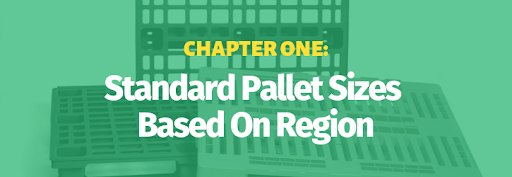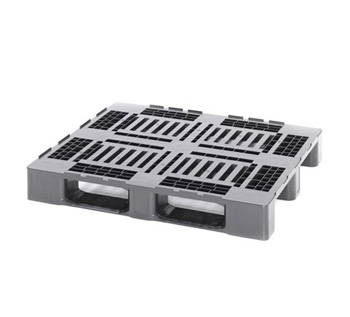Plastic Pallets: The Ultimate Guide To Standard Size Plastic Pallets For 2019
30 Sep 2019

Introduction
Historically pallet sizes used to vary drastically between different countries.
As you can imagine this would cause many issues for international trade.
Thankfully, great progress has been made in this realm of standardisation and reusability.
This was a very important development to improve global trade. There are now a list of 6 pallet sizes outlined by the ISO (International Standards Organization).
However, it’s important to know that these 6 pallet sizes are not the only pallet sizes considered standard.
In fact, each region, Europe, North America, Australia and Asia have their own set of standard pallet sizes.
We’ll start by discussing these geographic standard sizes before looking at how these fit in with the 6 ISO approved sizes.
Continue reading to learn which pallet sizes are now standard and used throughout international trade.
Contents
Chapter 1: The Different Types Of Plastic Pallets
Chapter 2: What Are The Standard Pallet Sizes?
Chapter 3: Pallet FAQs
Chapter 4: Conclusion

Chapter One: The Different Types Of Plastic Pallets
First of all to understand the different standard sizes of pallets we have to discuss all the different types of plastic pallet which correspond to different regions around the globe.
First of all we have EUR Pallets, EPAL Pallets and Europallets. These as you may deduce are pallets that are commonly found in the European market.
If you’re operating throughout Europe then these are likely the pallets you will be dealing with and need to use.
Here is a comprehensive list of all of the different standard Euro pallets and their sizes:
| Type of the Pallet | Dimensions of the Plastic Pallet (w x l) | |
| (mm) | (inches) | |
| EUR, EUR 1 | 800 * 1200 | 31.50 * 47.24 |
| EUR 2 | 1200 * 1000 | 47.24 * 39.37 |
| EUR 3 | 1000 * 1200 | 39.37 * 47.24 |
| EUR 6 | 800 * 600 | 31.50 * 23.62 |
| 600 * 400 | 23.62 * 15.75 | |
| 400 * 300 | 15.75 * 11.81 | |
Here is an example of a standard 1200 mm x 1000 mm Eur Pallet.

We’ll discuss later how these fit in with the 6 ISO approved pallet sizes in the next chapter.
Next up we have standard pallet sizes for North America.
These are the two different pallet sizes which are commonly found in supply chains throughout North America.
However, the 1016 mm x 1219 mm pallet is the most common of these.
| Plastic Pallet Dimensions (L * W) | Specific Application of Plastic Pallet in Industries | |
| (mm) | (inches) | |
| 1016 * 1219 | 40 * 48 | Groceries |
| 1067 * 1067 | 42 * 42 | Paint & telecommunication |
| 1219 * 1219 | 48 * 48 | Drums |
| 1219 * 1016 | 48 * 40 | Cement & military |
| 1219 * 1067 | 48 * 42 | Beverage & chemical |
| 1016 * 1016 | 40 * 40 | Dairy |
| 1219 * 1143 | 48 * 45 | Automotive |
| 1118 * 1118 | 44 * 44 | Chemical & drum |
| 914 * 914 | 36 * 36 | Beverage |
| 1219 * 914 | 48 * 36 | Packaged paper, beverage & shingles |
| 889 * 1156 | 35 * 45.5 | Military |
| 1219 * 508 | 48 * 20 | Retail stores |
As you can tell, the different sizes are typically used for different industries.
Next up is Asia.
Interestingly this region has integrated the ISO and European Standard Pallet sizes into their supply chains.
There are two common pallet sizes found in Asia, which are:
| Dimensions of the Plastic Pallet (l x w) | Comments | |
| (mm) | (inches) | |
| 1100 * 1100 | 43.30 * 43.30 | An ISO approved pallet |
| 1200 * 1000 | 39.37 * 47.24 | An ISO approved pallet |
The final region is Australia.
Australian supply chains typically use the 1165 mm by 1165mm pallet size which is one of the ISO approved sizes.

Chapter Two: What Are The Standard Pallet Sizes?
Now we’ve covered the different region specific standard pallet sizes we can look into the 6 ISO approved pallet sizes.
But first, who exactly are the ISO and how have they set out global standard pallet sizes?
The ISO or International Organisation for Standardisation has been developing and publishing international standards since 1947.
Their headquarters are located in Geneva, Switzerland and has 164 members. To date they have published 22,803 International Standards.
The ISO produce documents that provide requirements, specifications, guidelines or characteristics that can be used consistently to ensure that materials, products, processes and services are fit for their purpose.
As of writing there are six different ISO approved standard pallet sizes.
These are laid out in the table below:
| Plastic pallet dimensions | Region the plastic pallet is commonly used | Amount of wasted floor in ISO containers (%) | |
| Dimensions – l*w (mm) | Dimensions – l*w (inches) | ||
| 1016 * 1219 | 40.00 * 48.00 | North America | 3.7 |
| 1000 * 1200 | 39.37 * 47.24 | Europe and Asia | 6.7 |
| 1165 * 1165 | 45.90 * 45.90 | Australia | 8.1 |
| 1067 * 1067 | 42.00 * 42.00 | North America, Europe and Asia | 11.5 |
| 1100 * 1100 | 43.30 * 43.30 | Asia | 14.0 |
| 800 * 1200 | 31.50 * 47.24 | Europe | 15.2 |
These six pallet sizes are detailed in the ISO Standard 6780: Flat pallets for intercontinental materials handling – Principal dimensions and tolerances.
These standard pallet sizes aim to minimise the amount of wasted floor space in ISO containers.
The table also states which region specific pallets are most commonly found.
Some of these ISO standard sizes are the same as the region based standards. This helps to improve supply chains in those specific areas as well as globally.
Whilst these sizes are internationally recognised standards it’s still important that you consider the region your pallet will be shipped when purchasing them for your supply chain.
For instance, if you’re only shipping throughout Europe you’ll likely want the 800mm * 1200mm ISO pallet.
However, if you’re based in North America you’d be better off selecting the 1016 mm x 1219 mm ISO pallet.

Chapter Three: Pallet FAQs
Here are some frequently asked questions and answers on standard pallet sizes:
Q. What is the size of a standard UK pallet?
The standard size of a UK plastic pallet is 1200 x 1000mm. It is available in a number of pallet types and weight bearing capacities.
Q. What size is a blue planet?
Typically blue pallets will be 1200 mm x 1000mm this is because they likely belong to a pallet pool organisation.
Q. What size is a standard CHEP pallet?
A standard CHEP pallet is usually 1200 mm x 800mm and is for general use and can be safely used for most applications.
Q. How do I measure a pallet?
To ascertain the size of the pallet you will need to measure the base of the pallet. You’ll need to know the width, height and depth to find its size.
Q. How many pallets can you fit in a 53 foot trailer?
A 53-foot-long trailer can fit a maximum of 30 pallets on the floor of the trailer. To pack a trailer with 30 pallets, industry standard pallets of 40 inches by 48 inches must be packed in two rows with the wide sides facing the front and back of the trailer.

Chapter Four: Conclusion
So there we have it.
A complete rundown of the different standard pallet sizes that exist.
We’ve identified that different regions have their own standard sizes which makes trading in those areas much easier.
We’ve also acknowledge the six different ISO standard pallets and how the different regions have incorporated some of these into their supply chains too.
This makes global and international trade much easier as pallets don’t have to be unloaded and reloaded which can be costly.
However, before you purchase a pallet check the standard sizes for the region in which your pallet will be shipped too!
